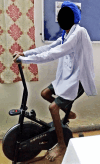The Impact of Pulmonary Rehabilitation in Acute Exacerbation of Chronic Obstructive Pulmonary Disease (COPD): A Case Report
- PMID: 38576670
- PMCID: PMC10993079
- DOI: 10.7759/cureus.55537
The Impact of Pulmonary Rehabilitation in Acute Exacerbation of Chronic Obstructive Pulmonary Disease (COPD): A Case Report
Abstract
This study focuses on a 56-year-old male laborer who presented to the respiratory department with grade III dyspnea persisting for 20 days, aggravated in the mornings, accompanied by chest pain over the last two days. The patient reported a productive cough producing yellowish sputum for 15 days and an ongoing fever during this period. With a two-year medical history of seasonal bronchial asthma, the patient had been using an inhaler three times daily for the past month. Additionally, a 20-year history of smoking, averaging five cigarettes per day, was disclosed. Investigations revealed hyperinflation of the lungs on X-ray, indicative of an acute exacerbation of chronic obstructive pulmonary disease (AECOPD). The patient was prescribed a four-week pulmonary rehabilitation protocol, incorporating physiotherapy. Baseline assessments were conducted using outcome measures such as pulmonary function test (PFT), functional independence measure (FIM), and six-minute walk distance (6MWD) before initiating treatment to evaluate the patient's performance. Following the prescribed pulmonary rehabilitation regimen, notable improvements were observed in PFT, FIM, and 6MWD. These findings underscore significant enhancements in exercise tolerance and overall functional capacity. The results suggest that a structured pulmonary rehabilitation program can lead to meaningful clinical benefits in individuals experiencing AECOPD, particularly when tailored to individual patient needs and characteristics.
Keywords: acute exacerbation; chronic obstructive pulmonary disease; dyspnea; physical therapy; pulmonary rehabilitation.
Copyright © 2024, Waghe et al.
Conflict of interest statement
The authors have declared that no competing interests exist.
Figures
Similar articles
-
[Standard technical specifications for methacholine chloride (Methacholine) bronchial challenge test (2023)].Zhonghua Jie He He Hu Xi Za Zhi. 2024 Feb 12;47(2):101-119. doi: 10.3760/cma.j.cn112147-20231019-00247. Zhonghua Jie He He Hu Xi Za Zhi. 2024. PMID: 38309959 Chinese.
-
Effectiveness of Continuous Chest Wall Vibration With Concurrent Aerobic Training on Dyspnea and Functional Exercise Capacity in Patients With Chronic Obstructive Pulmonary Disease: A Randomized Controlled Trial.Arch Phys Med Rehabil. 2021 Aug;102(8):1457-1464. doi: 10.1016/j.apmr.2021.03.006. Epub 2021 Mar 26. Arch Phys Med Rehabil. 2021. PMID: 33781780 Clinical Trial.
-
Effect of high-flow nasal therapy during early pulmonary rehabilitation in patients with severe AECOPD: a randomized controlled study.Respir Res. 2020 Apr 15;21(1):84. doi: 10.1186/s12931-020-1328-z. Respir Res. 2020. PMID: 32293463 Free PMC article. Clinical Trial.
-
Exercise training for bronchiectasis.Cochrane Database Syst Rev. 2021 Apr 6;4(4):CD013110. doi: 10.1002/14651858.CD013110.pub2. Cochrane Database Syst Rev. 2021. PMID: 33822364 Free PMC article.
-
Tiotropium bromide. A review of its use as maintenance therapy in patients with COPD.Treat Respir Med. 2004;3(4):247-68. doi: 10.2165/00151829-200403040-00005. Treat Respir Med. 2004. PMID: 15350163 Review.
References
-
- A systematic review of workplace interventions to prevent low back pain. Maher CG. Aust J Physiother. 2000;46:259–269. - PubMed
Publication types
LinkOut - more resources
Full Text Sources
Miscellaneous



